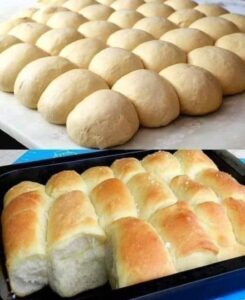Description
Homemade fluffiest bread rolls bring warmth from traditional German kitchens with simple ingredients. Gentle kneading and patient rising create pillowy textures perfect for family meals and weekend gatherings.
Ingredients
- 1 packet (2 ¼ tsps) active dry yeast
- ¼ cup (50 g) granulated sugar
- 4 cups (480 g) all-purpose flour
- 1 large egg
- 1 cup (240 ml) warm milk
- ¼ cup (57 g) unsalted butter, melted
- 1 tsp salt
- 2 tbsps butter, melted (for brushing on top)
Instructions
- Yeast Activation: Combine warm water, sugar, and active dry yeast in a large mixing bowl. Let the mixture rest until it becomes frothy and bubbly, indicating the yeast is alive and ready.
- Dough Formation: Blend the yeast mixture with flour, vegetable oil, and salt. Knead the ingredients thoroughly until a smooth, elastic dough forms that cleanly pulls away from the bowl’s sides.
- Initial Proofing: Transfer the dough to an oil-coated bowl, ensuring complete coverage. Drape with a damp cloth and place in a warm, undisturbed location to rise until doubled in size, approximately 1 hour.
- Shaping Rolls: Punch down the risen dough and divide into 16 equal portions. Gently roll each segment into smooth, uniform balls, arranging them on a lightly greased baking sheet with adequate spacing between each roll.
- Final Proofing and Baking: Cover the shaped rolls with a damp cloth and allow a second rise. Preheat the oven to 400F (200C). Bake the rolls for 18-20 minutes until they transform into golden-brown, crusty delicacies with a perfectly light interior.
Notes
Activate Yeast Perfectly: Ensure water temperature is between 100-110°F to wake up yeast without killing it; too hot or cold prevents proper activation and rise.
Knead with Confidence: Use the windowpane test to check gluten development – stretch a small piece of dough; if it stretches thin enough to see through without breaking, kneading is complete.
Proofing Environment Matters: Choose a warm, draft-free spot around 80-85°F for optimal dough rising; consider using an oven with the light on or atop a warm appliance to create ideal conditions.
Customize for Dietary Needs: Swap all-purpose flour with gluten-free blend for celiac-friendly version; replace vegetable oil with olive oil for added flavor, or use alternative milk for vegan adaptation.
- Prep Time: 15 minutes
- Cook Time: 18 minutes
- Category: Snacks, Dinner
- Method: Baking
- Cuisine: American
Nutrition
- Serving Size: 13
- Calories: 155
- Sugar: 5 g
- Sodium: 130 mg
- Fat: 6 g
- Saturated Fat: 4 g
- Unsaturated Fat: 2 g
- Trans Fat: 0 g
- Carbohydrates: 22 g
- Fiber: 1 g
- Protein: 3 g
- Cholesterol: 25 mg
